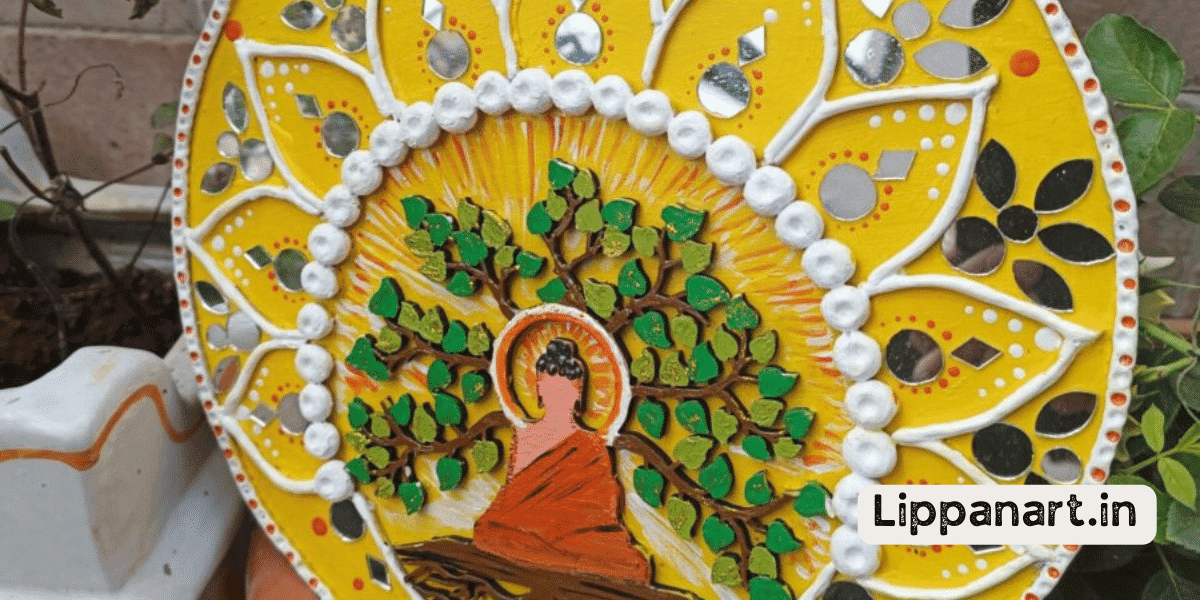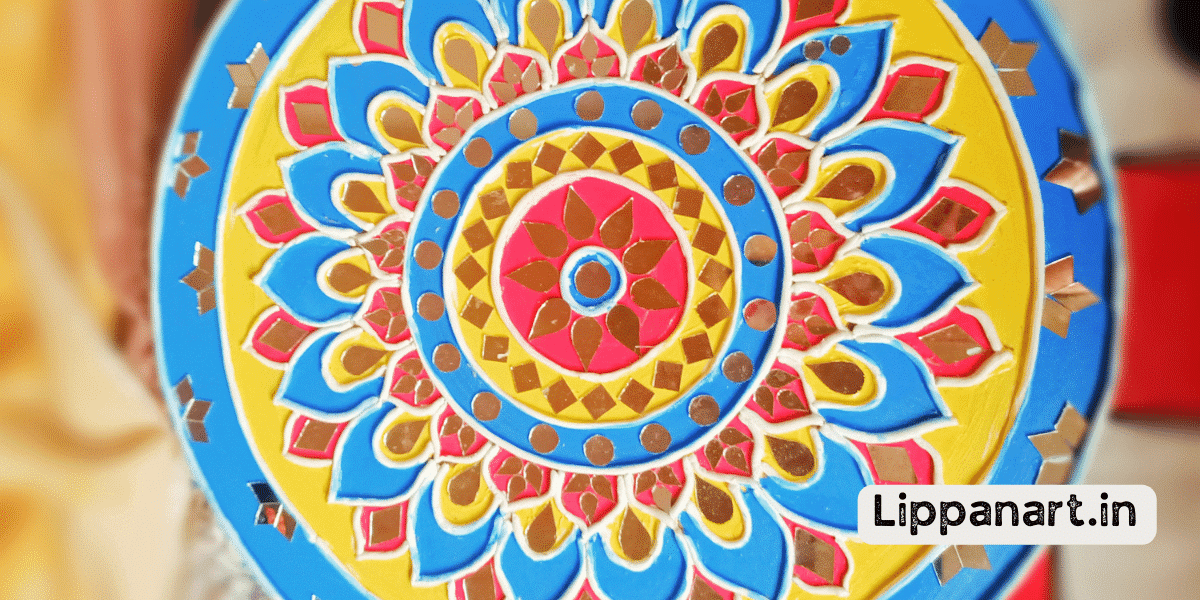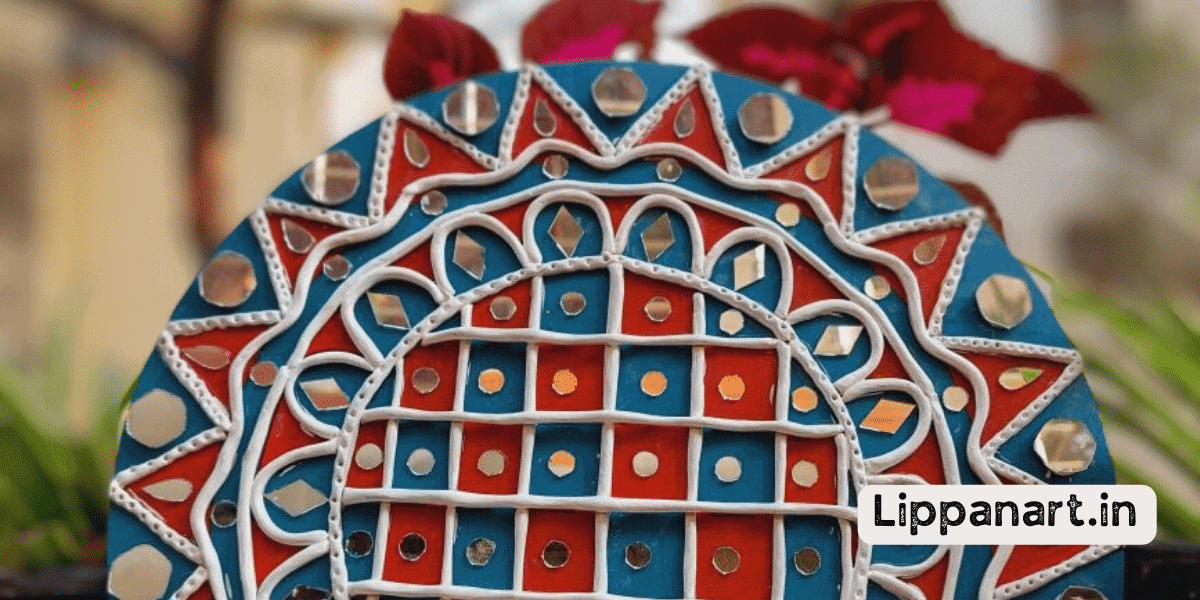Are you ready to be amazed? To see something that’s a true testament to creativity? Lippan art is here to blow your mind with intricate motifs and designs that will leave you mesmerised!
From geometric patterns and floral elements to sun, moon and celestial symbols, each piece of art stands out with its unique and innovative style.
Let’s look at all the incredible motifs used in lippan art!
Geometric Patterns
Geometric patterns are a common feature of lippan art. These artworks are an amalgamation of intricate geometric motifs, which typically involve geometrical shapes such as circles, squares, and triangles. These distinct patterns are often seen as a representation of balance, harmony, and order, all fundamental elements of lippan art.
The geometric motifs used in lippan art are often inspired by nature. For example, the repeating patterns of leaves, flowers, and other plants are often used in lippan art. The geometric patterns also represent the idea of cyclicality and are often used to symbolise the interconnectedness of nature.
The use of geometric motifs in lippan art also benefits the artist. The patterns provide structure and an order for the artist to follow, allowing them to focus more on the creative aspect of the work. Additionally, repeating the patterns helps create a captivating effect, leading to more visually interesting pieces.
Floral and Botanical Elements
Floral and botanical elements are common features in traditional Indian folk art. Uniquely vibrant floral designs are often used to decorate lippan art, sometimes as part of larger geometric patterns. The colour selection for these designs is usually based on the artist’s preferences, and the same design can look different when rendered in different colours. The botanical elements are often used to create a pleasing and whimsical aesthetic, often combined with geometric patterns and other motifs.
| Element | Description |
| Floral | Delicate yet vibrant designs |
| Botanical | Intricate elements inspired by nature |
| Colour Selection | Artist’s personal preference |
While most lippan art employs traditional motifs, some innovative artists are using these elements to create something new and exciting. By combining traditional elements with modern techniques, these artisans are pushing the boundaries of Indian folk art and creating exciting new works of art.
Sun, Moon, and Celestial Symbols
Sun, moon, and celestial symbols are often used in Indian folk art to represent the sky and its associated elements. In Lippan art, you can often find symbols like the sun, moon, stars, and planets. They often represent divine power or spiritual significance. As a result, these symbols are seen as a way to connect with the divine and honour the gods and goddesses of Indian mythology.
Sun and moon symbols are also used to represent the cycle of day and night and the cycle of life and death. Celestial symbols represent the eternal cycle of life and the divine power that governs the universe. They also symbolise the connection between humans and the divine, honouring the gods and goddesses of Indian mythology.
In addition, celestial symbols can represent the night sky’s beauty and mystery and the universe’s vast expanse.
Animals and Birds
Animals and birds are often featured in Indian folk art, representing a variety of meaningful themes. From cows to peacocks, these creatures are depicted in bright colours and intricate designs, making them a staple of Lippan art. Animals are typically seen as symbols of strength, power, wisdom, and fertility, while birds are often associated with freedom and joy. In this art form, animals and birds represent many motifs, such as protection, prosperity, and good luck.
In Lippan art, animals and birds are used as motifs and as a way to represent important characters in Hindu mythology. For example, Lord Ganesha, the god of wisdom, is often depicted with a mouse, while his vehicle is a peacock. Animals are also used to represent the god Vishnu’s avatars, including a fish, tortoise, boar, and lion. As such, animals and birds become a way to convey complex stories and ideas.
The use of animals and birds in Lippan art is a way to bring the beauty of nature into the art form. Through the symbolism of animals and birds, the artist can depict stories, beliefs, and values interestingly and creatively. It is a powerful form of communication that allows viewers to connect with the art meaningfully. While many Lippan art motifs are used to bring luck and good fortune, animals and birds can also be used to tell stories of strength and power.
- Editor’s Choice
- Best Seller
- Amazon Choice
Cultural and Traditional Symbols
Cultural and traditional symbols in India represent important stories, beliefs, and values. This is especially true in Lippan art, a form of decorative folk art that uses mirrors, clay, and other materials to create intricate designs.
Lippan artworks are often embellished with cultural symbols such as flowers, trees, birds, and even deities. These symbols are thought to bring good luck, prosperity, and protection to the creator and the viewer. For example, a Lippan artwork may be adorned with images of the goddess Lakshmi or the god Ganesh, believed to bring wealth and success.
Similarly, mirrors are a common motif in Lippan art because they are believed to ward off evil spirits. Mirrors also represent the duality of life, reflecting both the beauty and darkness of the human experience.
Through these symbols, Lippan art creates a visually stunning design and conveys a powerful and meaningful message.
Abstract and Contemporary Designs
Abstract and contemporary designs are becoming increasingly popular in Indian art, offering a modern interpretation of traditional symbols and motifs. Lippan art is no exception, with artisans adding abstract patterns, bold shapes, and unique colour choices. By introducing these modern techniques, they can create eye-catching works of art that can be adorned in many different ways.
The contemporary designs used in Lippan art are aesthetically pleasing and symbolise the progress and evolution of Indian art. These abstract designs are often inspired by traditional motifs but are given a modern twist with the introduction of new materials and techniques. By combining the traditional with the modern, artisans can create both traditional and progressive art. This type of art appeals to a wide range of consumers, as it is visually pleasing and culturally relevant. Furthermore, the abstract and contemporary designs of lippan art are often more affordable than their traditional counterparts.
Paisley and Swirl Motifs
You now shift your focus to the ever-popular paisley and swirl motifs, staples of lippan art. The paisley pattern is a design that looks like a droplet, often featuring a curved teardrop shape with a curved upper end. On the other hand, swirl motifs are composed of curved shapes that create an overall circular design. These motifs are incredibly versatile and can be used in various abstract and contemporary designs.
The beauty and versatility of these motifs can be emphasised using a table, as seen below.
| Motif | Description | Use |
|---|---|---|
| Paisley | Teardrop shape with a curved upper end | Abstract and Contemporary |
| Swirl | Composed of curved shapes to create a circular design | Abstract and Contemporary |
The paisley and swirl motifs add texture and colour to any lippan art piece. Furthermore, the versatility of these motifs allows for a wide range of creative possibilities. They can be used alone in a design or combined with other motifs to create a unique and eye-catching look. The paisley and swirl motifs are timeless and can add a touch of class to any lippan art project.
Mirror Inlays and Reflective Patterns
Mirror inlays and reflective patterns are a great way to add a unique touch to any art project. In Lippan art, these motifs often create amazing designs incorporating traditional shapes and textures. By using mirror tiles and other reflective materials, artisans can create stunning pieces of art that truly stand out.
The reflective properties of the materials bring a new dimension to the art, creating a mesmerising and captivating effect. Many of the motifs used for Lippan art are based on ancient symbols, but these designs become modern and innovative by adding reflective elements. The combination of old and new is truly inspiring and can be used to create truly unique pieces.
Religious and Spiritual Icons
Building upon the previous discussion of mirror inlays and reflective patterns in Lippan art, religious and spiritual icons are another popular motif. These religious and spiritual figures often carry symbolic meaning and serve as a reminder of the importance of faith and spiritual growth.
Icons of deities, prophets, and other religious figures are often seen in Lippan art, symbolising their significance in the culture. For example, the image of Lord Shiva is a popular motif in Lippan art, representing the god of destruction and transformation. Other religious figures such as Buddha, Ganesha, and Vishnu are often depicted in Lippan art, showing their importance as spiritual guides.
The use of religious and spiritual icons in Lippan art is a testament to the culture’s deeply held beliefs and values. These icons not only symbolise the strength of one’s faith but also serve as a reminder of the significance of spiritual development and peace.
- Editor’s Choice
- Best Seller
- Amazon Choice
Architectural and Structural Elements
Besides religious and spiritual icons, architectural and structural elements are major components of Lippan art. The artisans use clay as their medium to create walls and structures that are decorated with patterns and designs. These designs can vary from floral motifs to geometric shapes, and in some cases, the artisans may also use mirrors to create a unique effect. The walls and structures are built to be both aesthetically pleasing and meaningful, with each pattern, shape and design having significance.
| Element | Design | Significance |
|---|---|---|
| Walls | Geometric Shapes | Symbolise stability |
| Clay | Floral Motifs | Represent fertility and growth |
| Structure | Mirrors | Reflect light and create a unique effect |
The artisans take great care to ensure that their walls and structures are functional and beautiful. Combining the clay and the patterns ensures that the walls and structures have a unique and captivating look that can bring a sense of awe and admiration. The use of mirrors also adds a layer of complexity to the art, with the reflection of light creating a mesmerising effect. These architectural and structural elements will surely draw in any onlooker, providing them with a captivating and meaningful experience.
Frequently Asked Questions
How Does One Differentiate Between Lippan Art and Other Forms of Art?
You can differentiate Lippan art from other art forms by its bold motifs, intricate details and bright colours. Its unique patterns and shapes are sure to stand out from the rest.
What Materials Are Used in the Creation of Lippan Art?
Discover the materials to craft its intricate motifs – from colourful glass beads and shells to mirrors and clay. Let your imagination explore the possibilities of this captivating art form.
What Is the Historical Significance of Lippan Art?
It has a unique history of being a powerful symbol of female empowerment and creativity, with the motifs representing aspects of life such as prosperity, fertility, and harmony.
What Is the Purpose of Incorporating Religious and Spiritual Icons in Lippan Art?
Incorporating religious and spiritual icons in lippan art brings a unique beauty and meaning to the artwork while also communicating the artist’s beliefs and values. It’s a creative way to express faith and tradition.
Conclusion
You’ve seen it all – from geometric patterns to floral and botanical elements, sun, moon, and celestial symbols, animals and birds, cultural and traditional symbols, paisley and swirl motifs, mirror inlays and reflective patterns, religious and spiritual icons, to architectural and structural elements.
Lippan art is a masterpiece of creativity and craftsmanship. Its intricate designs, colourful motifs, and intricate detailing make it an exceptional art form that will dazzle and delight its audience.
So, please take a moment to marvel at the majestic beauty of lippan art and let its dazzling designs transport you to a place of wonder and delight.














